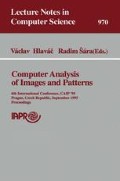Abstract
The automated generation of 3D CAD models of real objects from different camera views poses frequently problems in regard to man made objects. Models do not match the expectations of a human observer, because house walls are not perpendicular, streets are not planar, windows and doors are not rectangular, etc. The new knowledge based modeling system AIDA handles these problems by using an explicit knowledge base about the semantics of the scene to be modeled including knowledge about the visual appearance of scene objects. During the analysis of the scene constraints for the modeling are derived automatically and are applied during model generation.
Preview
Unable to display preview. Download preview PDF.
References
Koch, R., ”3-D Surface Reconstruction from Stereoscopic Image Sequences”, International Conference on Computer Vision ICCV'95, Boston, June 1995.
Grau, O., Tönjes, R., ”Knowledge Based modelling of Natural Scenes”. Proc. of the European Workshop on Combined Real and Synthetic Image Processing for Broadcast and Video Production. 23.–24. Nov. 1994 Hamburg, Germany
Röning, J., Taipale, T., ”Stereo-Based 3-D Scene Interpretation Using Semantic Nets”, SPIE Vol. 1608 Intelligent Robots and Computer Vision X (1991)
McKeown, et al., ”Rule-Based Interpretation of Aerial Imagery”, IEEE Trans. on Pattern Analysis and Machine Intelligence, Vol. PAMI-7, No. 5, pp. 570–585, Sept. 1985.
Matsuyama, T., Hwang, V.S.-S., ”SIGMA: A Knowledge-Based Aerial Image Understanding System”, Plenum Press, New York 1990
Foresti, G.L., Murino, V., Regazzoni, C. S., Vernazza, G., ”Distributed spatial reasoning for multisensory image interpretation”, Signal Processing 32, May 1993, pp. 217–255.
Clément, V., Giraudon, G., Houzelle, S., Sandakly, F., ”Interpretation of Remotely Sensed Images in a Context of Multisensor Fusion Using a Multispecialist Architecture”, IEEE Trans. on Geoscience and Remote Sensing, Vol. 31, No. 4, July 1993
Niemann, H., Sagerer, G., Schröder, S., Kümmert, F., ”ERNEST: A Semantic Network System for Pattern Understanding”, IEEE Trans. on Pattern Analysis and Machine Intelligence, Vol. 12, No. 9, pp. 883–905, Sept. 1990.
Author information
Authors and Affiliations
Editor information
Rights and permissions
Copyright information
© 1995 Springer-Verlag Berlin Heidelberg
About this paper
Cite this paper
Liedtke, C.E., Grau, O., Growe, S. (1995). Use of explicit knowledge for the reconstruction of 3-D object geometry. In: Hlaváč, V., Šára, R. (eds) Computer Analysis of Images and Patterns. CAIP 1995. Lecture Notes in Computer Science, vol 970. Springer, Berlin, Heidelberg. https://doi.org/10.1007/3-540-60268-2_348
Download citation
DOI: https://doi.org/10.1007/3-540-60268-2_348
Published:
Publisher Name: Springer, Berlin, Heidelberg
Print ISBN: 978-3-540-60268-2
Online ISBN: 978-3-540-44781-8
eBook Packages: Springer Book Archive

